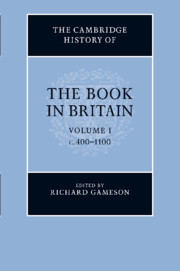Book contents
- Frontmatter
- 1 From Vindolanda to Domesday: the book in Britain from the Romans to the Normans
- PART I THE MAKING OF BOOKS
- 2 The material fabric of early British books
- 3 Anglo-Saxon scribes and scriptoria
- 4 Writing in the Insular world
- 5 Script in Wales, Scotland and Cornwall
- 6 English vernacular script
- 7 Latin script in England c. 900–1100
- 8 The design and decoration of Insular gospel-books and other liturgical manuscripts, c. 600 – c. 900
- 9 The decoration of the earliest Welsh manuscripts
- 10 Book decoration in England, c. 871 – c. 1100
- 11 Bookbindings
- PART II THE CIRCULATION OF BOOKS
- PART III TYPES OF BOOKS AND THEIR USES
- PART IV COLLECTIONS OF BOOKS
- PART V CODA
- Bibliography
- Concordance of named manuscripts
- Index of manuscripts
- General Index
- Plate 4.1: The Lindisfarne Gospels"
- Plate 5.1: The Lichfield/St Chad Gospels"
10 - Book decoration in England, c. 871 – c. 1100
from PART I - THE MAKING OF BOOKS
Published online by Cambridge University Press: 28 March 2012
- Frontmatter
- 1 From Vindolanda to Domesday: the book in Britain from the Romans to the Normans
- PART I THE MAKING OF BOOKS
- 2 The material fabric of early British books
- 3 Anglo-Saxon scribes and scriptoria
- 4 Writing in the Insular world
- 5 Script in Wales, Scotland and Cornwall
- 6 English vernacular script
- 7 Latin script in England c. 900–1100
- 8 The design and decoration of Insular gospel-books and other liturgical manuscripts, c. 600 – c. 900
- 9 The decoration of the earliest Welsh manuscripts
- 10 Book decoration in England, c. 871 – c. 1100
- 11 Bookbindings
- PART II THE CIRCULATION OF BOOKS
- PART III TYPES OF BOOKS AND THEIR USES
- PART IV COLLECTIONS OF BOOKS
- PART V CODA
- Bibliography
- Concordance of named manuscripts
- Index of manuscripts
- General Index
- Plate 4.1: The Lindisfarne Gospels"
- Plate 5.1: The Lichfield/St Chad Gospels"
Summary
The book decoration that was practised in England during the two centuries between the reigns of Alfred the Great and William Rufus ranges from isolated decorated initials in modestly conceived volumes to elaborate full-page miniatures in luxurious ones. The present chapter will outline the main chronological development of this artform, and will then consider aspects of its patronage, production and purpose.
The manuscripts associated with the literary programme of Alfred the Great (reigned 871–99) seem to have been qualitatively very modest – something which in itself lends support to the king’s pessimistic view of ninth-century Southumbrian literary skills. The decline that he so eloquently lamented necessitated a new start, and although there are unquestionably links with work done earlier in the century, the manuscript art that rose from the ashes – quite literally in the case of centres that had been ravaged by the Vikings – followed new paths. Royal support notwithstanding, the revival was slow. The young Alfred may have admired fine initials (as his biographer, Asser, claimed), but such were beyond the scribes whom he had at his disposal in the 890s: those in the contemporary manuscripts of his Old English translation of Gregory the Great’s Regula pastoralis are very humble indeed – crude pen-drawn letters elaborated with small and ungainly beast heads, human faces and interlace twists.
Keywords
- Type
- Chapter
- Information
- The Cambridge History of the Book in Britain , pp. 249 - 293Publisher: Cambridge University PressPrint publication year: 2011

